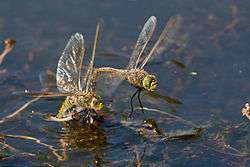Australian emperor
| Australian emperor dragonfly | |
|---|---|
 | |
| Scientific classification | |
| Kingdom: | Animalia |
| Phylum: | Arthropoda |
| Class: | Insecta |
| Order: | Odonata |
| Family: | Aeshnidae |
| Genus: | Hemianax |
| Species: | H. papuensis |
| Binomial name | |
| Hemianax papuensis Burmeister, 1839 | |
Hemianax papuensis (also known as the Australian emperor dragonfly[1] and yellow emperor dragonfly)[2] is a species of dragonfly in the Aeshnidae family that can be found in Australia. It is black coloured with yellow dots along the tail.[3]
Description
The Australian emperor is a very large dragonfly, up to 70 mm long. Its abdomen is marked boldly in black and yellow. The thorax is greenish-grey. The head is yellow with a T-shaped mark on the forehead (frons). The eyes are yellow-green. The leading edges of the wings are yellow. The insect habitually hunts fairly slowly, patrolling up and down like other hawkers, with short bursts at high speed.[4]
Their wingspan is 11 centimetres (4.3 in). Males and females are similar.[5]
Distribution and habitat
The Australian emperor is found throughout Australia. In the state of Victoria, it has a split distribution: below about 600 metres in altitude, and above about 1200 metres, apparently because it avoids forested areas. It is also found in New Zealand, New Guinea, the Cocos-Keeling Islands, Java, Sumba and New Caledonia.[6][7]
The Australian emperor is widespread and common on larger bodies of water with tall vegetation on the banks. Like other hawkers, it may hunt far from water. It flies throughout the summer from September to May.[4]
Behaviour

The Australian emperor is notable as the dragonfly in which motion camouflage was studied by Mizutani et al.: males of H. papuensis are fiercely territorial, and to approach and attack rivals, the males choose a flight path that keeps their image as seen by the target still with respect to a landmark point. The attacking dragonfly thus looms larger in the target's eyes, but otherwise does not seem to move until it is very close.[8][9][10]
The males are very protective of their females. In case of intrusion of another individual, it will drive him away by engaging in a series of noisy air battles. Females lay their eggs under water.[2]
Bibliography
- Günther Theischinger and John Hawking. The Complete Field Guide to Dragonflies of Australia. Csiro Publishing, 2006. ISBN 978 0 64309 073 6
See also
References
- ↑ "Common name". Brisbane Insects. Retrieved April 27, 2012.
- 1 2 "Second common name and habitat". Oocities. Retrieved April 27, 2012.
- ↑ Colour
- 1 2 Hemianax papuensis Retrieved 16 January 2012
- ↑ Description Archived April 26, 2013, at the Wayback Machine.
- ↑ Esperance Fauna Retrieved 16 January 2012
- ↑ Theischinger, 2006.
- ↑ Hopkin, Michael (June 5, 2003). "Nature News". Dragonfly flight tricks the eye. Nature.com. Retrieved January 16, 2012.
- ↑ Mizutani, A. K., Chahl, J. S. & Srinivasan, M. V. (June 5, 2003). "Insect behaviour: Motion camouflage in dragonflies". Nature. 65 (423): 604. doi:10.1038/423604a.
- ↑ Glendinning, Paul (27 January 2004). "Motion Camouflage" (PDF). The mathematics of motion camouflage. The Royal Society. Retrieved November 25, 2011.
External links
| Wikimedia Commons has media related to Hemianax papuensis. |
